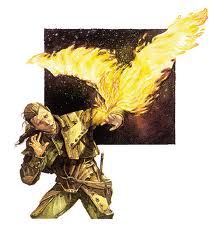FREQUENCY: Very
rare ([Tropical Wilderness Swamp], [Tropical Wilderness Desert])
FREQUENCY:
Very rare ([Dungeon Level II])
FREQUENCY:
Rare ([Ethereal Plane])
NO. APPEARING: 11-20
ARMOR CLASS: 8
MOVE: 6" / 20" (MC: B)
HIT DICE: 2
% IN LAIR: 50%
TREASURE TYPE: [I]
NO. OF ATTACKS: 1
DAMAGE/ATTACK: 2-8
SPECIAL ATTACKS: Nil
SPECIAL DEFENSES: Immune
to Fire
MAGIC RESISTANCE: Standard
INTELLIGENCE: Semi-
ALIGNMENT: Neutral evil
SIZE: S
LEVEL/X.P. VALUE: II | 28
+ 2
The fire
bat is a denizen of the Elemental Plane of Fire, and, although
rather common there, it seldom
appears in the Prime Material Plane. Its
body is bat-like, about 2
feet long, with a wingspan approaching 4 feet;
its entire body is flaming,
and it radiates a temperature of several
hundred degrees. Its mouth
is small but the fangs therein are razorsharp,
and the damage from burning
affects the victim more than the
blood drain (hence 2-8 points
of damage per round). The skin of the fire
bat is tough and leathery,
and even the relativelythin wings are difficult
to pierce.
Fire bats live in colonies
usually numbering from 1-2 dozen. Naturally,
theywill onlylair in very
hot placessuch asvolcanoes, near hotsprings,
and, of course, on their
native plane. How they travel to the Prime
Material Plane is a mystery,
but some sages have speculated that when
fire elementals are summoned,
once in a great while some fire batswill
appearwith them; andwoe to
theconjurer,forthefire batsare not under
the mage's control at all!
Fire bats reproduce by fission after gorging
themselveson blood, so even
1 fire bat escaping into thisplanecanstart
a colony and can replace
any casualties. A fire bat colony will not grow
very large, however, for
they will instinctively limit their population to
the available food supply.
When fire bats engage an opponent,
they make swooping attacks as
they attempt to attach themselves
to the victim. Once they have attached
themselves, fire bats do
not need to roll for further attacks and
will automatically burn and
bleed their victimsfor a total of 3 rounds(the
first round they scored a
hit plus 2 more rounds). At the end of 3 rounds,
thesatiatedfirebatwilldropoff
andreturntoitslair. Ifthevictimdiesbefore
3 round sare over, the unsatiated
fire bats will attack other opponents to
finish feeding (but will
never drain more than 3 rounds'worth of blood
whether from 1,2, or 3 victims).
Fire bats can detect invisible opponents
because of an advanced sonar
sense and infravision; they attack invisible
targets without penalty.
Unlike ordinary bats, fire bats are not
harmed bysunlight(orother
bright 1ights)andcanseewithin the normal
vision range quite well.
Fire bats are allies of fire elementals and will
never attack them.
Fire bats are pack hunters,
and an attack by these creatures is a marvel
of teamwork. Every member
of the victim's group is attacked by an
approximatelyequal numberoffire
bats: if 12fire batsattackatotaIof4
victims, 3 bats will attack
each individual; if the same number attack 9
victims, 6 would be attacked
by 1 bat each and 3 unlucky victims by 2
bats each (chosen at random).
If the number of fire bats ever falls below
25% of their starting force
(whether from casualties or satisfied returnees),
the fire bats will all instantly
withdraw and attempt to escape to
their lair. If cornered in
their lair, they will fight ferociouslyto the death.
When they die, a burst of
flame envelopes them and their physical
bodies are transported back
to the Elemental Plane of Fire, where they
are reborn.
The lair of a fire bat colony
tends to be rocky and cavelike, with many
exits and labyrinthine passages
but only one large, easily noticeable
entrance. Treasure is likely
to be in the form of gems and jewelry,
because fire bats love the
sparkling stones and especially prize rubies,
jacinths, andcarnelians.
Oneor 2young fire bats(under 1 yearold)may
be found in the lair if a
huntingpack is destroyed, andeach young fire bat
will have one-half the hit
dice and damage per attack of an adult.
Fire bats move by an awkward
hop-walk on the ground or (more efficiently)
by flight. Fire bats use
true flight and not gliding, because hot
internal gases lighten them
a great deal. Water scares fire bats, but it
takes a minimum of 10 gallons
of cool water to douse 1 fire bat's
external fires. Once extinguished,
it requires 10 rounds of drying off
before the fire bat can ignite
again. During this period it cannot fly, and
will only do 1-4 points of
damage if it attacks successfully. Fire bats can
glide through hot solutions
(including lava and magma) at their flying
speed, for they are at home
in anything involving fire.
